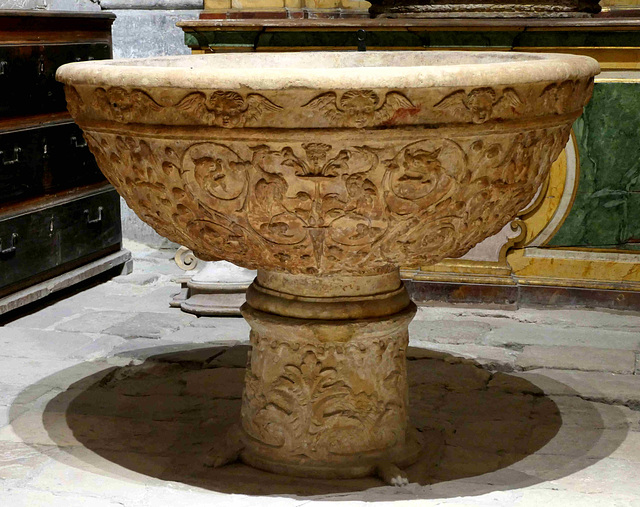Cuenca - Catedral de Santa María y San Julián
Cuenca - Catedral de Santa María y San Julián
Cuenca - Catedral de Santa María y San Julián
Cuenca - Catedral de Santa María y San Julián
Cuenca - Catedral de Santa María y San Julián
Cuenca - Catedral de Santa María y San Julián
Cuenca - Casas Colgadas
Cuenca - Casas Colgadas
Cuenca - Puente de San Pablo
Cuenca - Convento de San Pablo
Cuenca - Convento de San Pablo
Location
Lat, Lng:
Lat, Lng:
You can copy the above to your favourite mapping app.
Address: unknown
Lat, Lng:
You can copy the above to your favourite mapping app.
Address: unknown
See also...
Keywords
Authorizations, license
-
Visible by: Everyone -
All rights reserved
-
36 visits
Cuenca - Catedral de Santa María y San Julián


When the Muslims conquered the area in 714, they recognized the value of this strategic location and built a fortress between two ravines.
In 1076, Cuenca was unsuccessfully besieged by Sancho Ramírez of Aragon. In 1080 there was a treaty between King Yahya al-Qadir and Alfonso VI. of León and Castile, through which some fortresses were ceded in exchange for military aid.
Cuenca was then conquered by Al-Mu'tamid ibn Abbad in 1086. However, when his country was attacked by the Almoravids, he again offered Cuenca to Alfonso in return for military support. The first Christian troops entered the city in 1093. However, the Almoravids conquered it in 1108. As part of the Reconquista, King Alfonso VIII conquered the city from the Moors in 1177 after a nine-month siege. The Diocese of Cuenca was founded in 1183. Alfonso X gave Cuenca the title “ciudad” in 1257.
Cuenca is divided into two different areas, the Old Town and the New Town. The first is located on a rocky hill bordered on the north by the gorges of the Júcar River and on the south by its tributary, the Huécar River. Cuenca is a vibrant city with a population of about 55.000.
The Cathedral, inspired by the early Gothic architecture of Central Europe (Soissons, Laon...), was built between 1196 and 1257, but many changes were made repeatedly in the following centuries. The entire choir area was renovated in the 15th century, and the decor of the apse were only created in the 17th/18th century.
In 1902, the bell tower collapsed after a lightning strike and damaged the facade, whose reconstruction in the neo-Gothic style, which was not true to the original, began eight years later. The current appearance shows that the structure remains unfinished.
The baptismal font
In 1076, Cuenca was unsuccessfully besieged by Sancho Ramírez of Aragon. In 1080 there was a treaty between King Yahya al-Qadir and Alfonso VI. of León and Castile, through which some fortresses were ceded in exchange for military aid.
Cuenca was then conquered by Al-Mu'tamid ibn Abbad in 1086. However, when his country was attacked by the Almoravids, he again offered Cuenca to Alfonso in return for military support. The first Christian troops entered the city in 1093. However, the Almoravids conquered it in 1108. As part of the Reconquista, King Alfonso VIII conquered the city from the Moors in 1177 after a nine-month siege. The Diocese of Cuenca was founded in 1183. Alfonso X gave Cuenca the title “ciudad” in 1257.
Cuenca is divided into two different areas, the Old Town and the New Town. The first is located on a rocky hill bordered on the north by the gorges of the Júcar River and on the south by its tributary, the Huécar River. Cuenca is a vibrant city with a population of about 55.000.
The Cathedral, inspired by the early Gothic architecture of Central Europe (Soissons, Laon...), was built between 1196 and 1257, but many changes were made repeatedly in the following centuries. The entire choir area was renovated in the 15th century, and the decor of the apse were only created in the 17th/18th century.
In 1902, the bell tower collapsed after a lightning strike and damaged the facade, whose reconstruction in the neo-Gothic style, which was not true to the original, began eight years later. The current appearance shows that the structure remains unfinished.
The baptismal font
kiiti, Fred Fouarge, Alexander Prolygin have particularly liked this photo
- Keyboard shortcuts:
Jump to top
RSS feed- Latest comments - Subscribe to the comment feeds of this photo
- ipernity © 2007-2024
- Help & Contact
|
Club news
|
About ipernity
|
History |
ipernity Club & Prices |
Guide of good conduct
Donate | Group guidelines | Privacy policy | Terms of use | Statutes | In memoria -
Facebook
Twitter

Sign-in to write a comment.